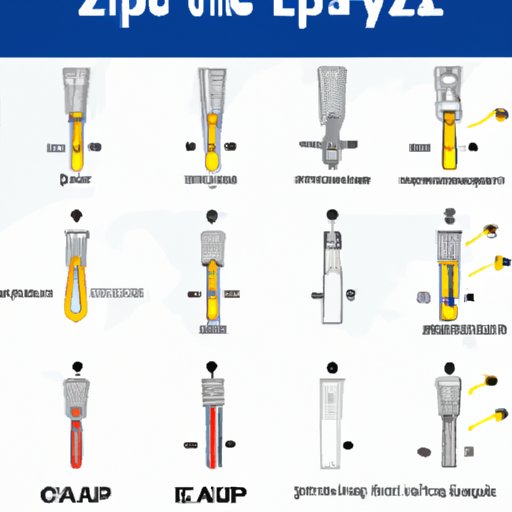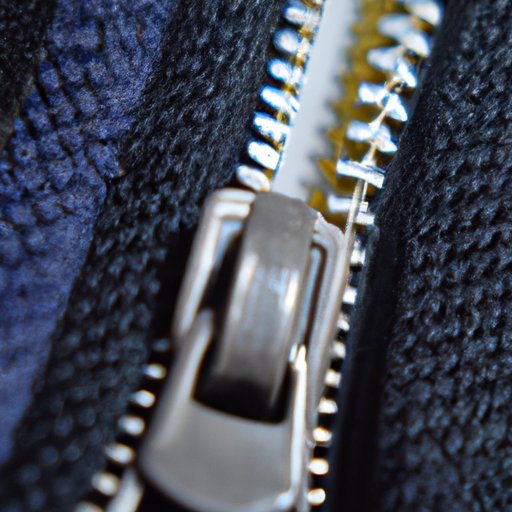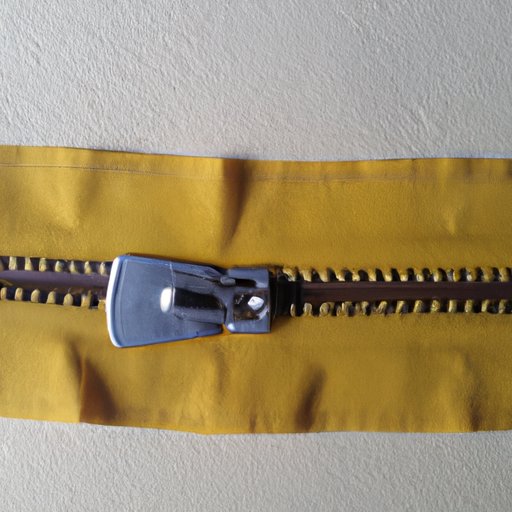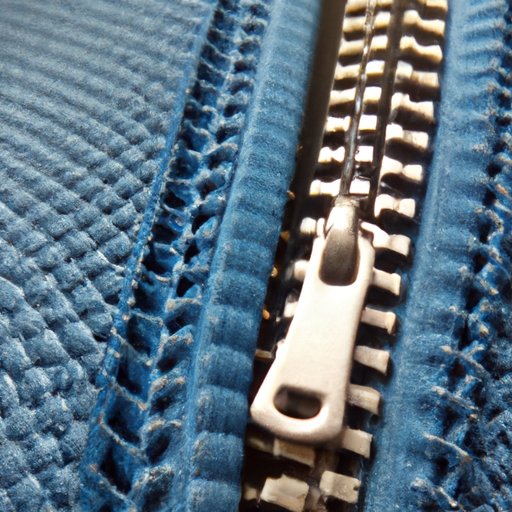Introduction
A zipper is a device that joins two pieces of fabric or material together by interlocking teeth along a track. Zippers are used in a variety of items such as clothing, bags, and shoes, as well as many other items. The purpose of a zipper is to provide a secure closure and make it easier to open and close items that would otherwise require lacing or buttons.
In this article, we will explore how a zipper works. We’ll take an illustrated guide to the mechanics of a zipper, examine its anatomy, discuss the history and function of zippers, and take a closer look at the design behind them. We’ll also provide a step-by-step guide on how to zip up a zipper.

An Illustrated Guide to How a Zipper Works
To understand how a zipper works, it helps to have a visual guide. Here is an illustration of a zipper and the various components that make it up:

Exploring the Mechanics of a Zipper
At its core, a zipper is a simple mechanical device. It consists of two rows of metal or plastic teeth that interlock when the slider moves up and down. The teeth are connected to two strips of fabric or material, which form the sides of the zipper. As the slider moves up and down, the teeth come together and create a secure closure.
The Anatomy of a Zipper
Now let’s take a closer look at the anatomy of a zipper. A zipper typically consists of four main components: the teeth, the tape, the slider, and the stopper. The teeth are the interlocking pieces of metal or plastic that come together when the slider is moved up and down. The tape is the fabric or material that the teeth are attached to and forms the sides of the zipper. The slider is the piece that moves up and down the zipper track and connects the teeth together. Finally, the stopper is the piece at the end of the zipper that prevents the slider from coming off.
A Step-by-Step Guide to Zipping Up
Now that you know the basics of how a zipper works, let’s take a look at how to zip up a zipper. Here’s a step-by-step guide:
- Start by aligning the two sides of the zipper. Make sure the teeth on both sides are lined up with each other.
- Grab the slider and move it up the zipper track. As you do this, the teeth will begin to interlock and the two sides of the zipper will come together.
- Continue moving the slider up the zipper track until it reaches the top. At this point, the zipper should be completely closed.
It’s important to note that zippers can be tricky to zip up. To make it easier, it helps to pull the two sides of the zipper apart slightly while zipping up. This gives the teeth more room to interlock and makes it easier for the slider to move up the zipper track.

A Comprehensive Look at How Zippers Work
Now that we’ve explored the basics of how a zipper works, let’s dive deeper into how each component works together to create a functioning zipper.
The teeth of a zipper are designed to interlock when the slider moves up and down the zipper track. As the slider moves up, the teeth of the two sides come together and create a secure closure. As the slider moves down, the teeth separate and the two sides of the zipper come apart.
The tape of a zipper is what holds the teeth in place and forms the sides of the zipper. The tape is usually made of a strong fabric or material that won’t easily tear or break.
The slider of a zipper is the piece that moves up and down the zipper track and connects the teeth together. The slider is usually made of metal or plastic and is designed to be easy to grip and move.
Finally, the stopper of a zipper is the piece at the end of the zipper that prevents the slider from coming off. The stopper is usually made of metal or plastic and is designed to keep the slider in place so it doesn’t slide off the zipper track.

The History and Function of Zippers
Zippers were invented in the late 19th century by Whitcomb Judson, an American inventor. According to The Atlantic, “Judson’s invention was a complicated affair, involving a series of clasps and hooks that had to be manually fastened and unfastened.” Despite its complexity, Judson’s invention was revolutionary, as it provided a much faster and easier way to open and close items than buttons or laces.
Today, zippers are used in a variety of items such as clothing, bags, and shoes. They are also used in many other items, such as tents, sleeping bags, and backpacks. Zippers provide a secure closure and make it easier to open and close items that would otherwise require lacing or buttons.
A Closer Look at the Design Behind a Zipper
The design of a zipper is just as important as its function. Different zipper designs offer different benefits, such as improved strength, durability, and ease of use. For example, some zippers feature double-sided teeth that interlock more securely than single-sided teeth. Other zippers feature larger teeth that are easier to grip and move.
The design of a zipper also affects its aesthetic appeal. Many zippers feature decorative elements such as colored tape or unique patterns. These elements can add a unique touch to the item they are used on.
Conclusion
In conclusion, zippers are a simple yet powerful device that has revolutionized the way we open and close items. A zipper consists of four main components – teeth, tape, slider, and stopper – that work together to create a secure closure. Zippers have been around since the late 19th century and are used in a variety of items, from clothing to tents. The design of a zipper is also important, as different designs offer different benefits such as improved strength and ease of use.
We hope this article has helped you gain a better understanding of how a zipper works.
(Note: Is this article not meeting your expectations? Do you have knowledge or insights to share? Unlock new opportunities and expand your reach by joining our authors team. Click Registration to join us and share your expertise with our readers.)
